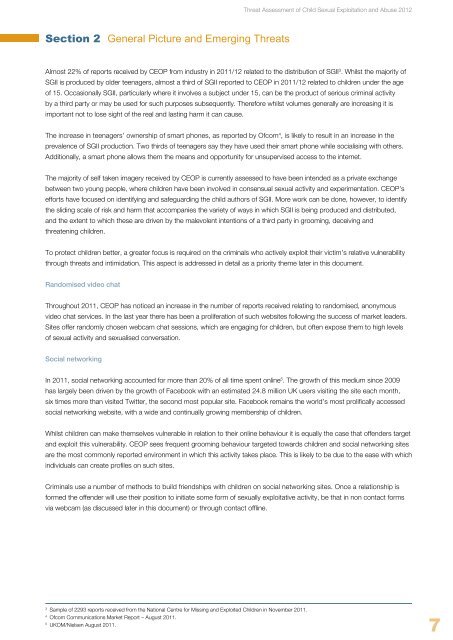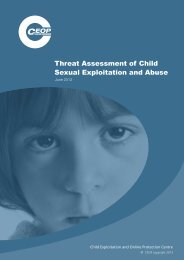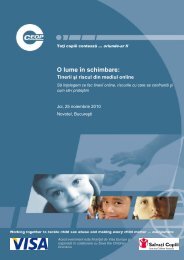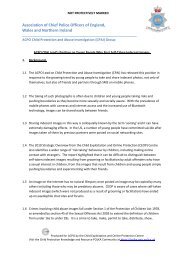Threat Assessment of Child Sexual Exploitation and Abuse - Ceop
Threat Assessment of Child Sexual Exploitation and Abuse - Ceop
Threat Assessment of Child Sexual Exploitation and Abuse - Ceop
Create successful ePaper yourself
Turn your PDF publications into a flip-book with our unique Google optimized e-Paper software.
Section 2 General Picture <strong>and</strong> Emerging <strong>Threat</strong>s<br />
Almost 22% <strong>of</strong> reports received by CEOP from industry in 2011/12 related to the distribution <strong>of</strong> SGII 3 . Whilst the majority <strong>of</strong><br />
SGII is produced by older teenagers, almost a third <strong>of</strong> SGII reported to CEOP in 2011/12 related to children under the age<br />
<strong>of</strong> 15. Occasionally SGII, particularly where it involves a subject under 15, can be the product <strong>of</strong> serious criminal activity<br />
by a third party or may be used for such purposes subsequently. Therefore whilst volumes generally are increasing it is<br />
important not to lose sight <strong>of</strong> the real <strong>and</strong> lasting harm it can cause.<br />
The increase in teenagers’ ownership <strong>of</strong> smart phones, as reported by Ofcom 4 , is likely to result in an increase in the<br />
prevalence <strong>of</strong> SGII production. Two thirds <strong>of</strong> teenagers say they have used their smart phone while socialising with others.<br />
Additionally, a smart phone allows them the means <strong>and</strong> opportunity for unsupervised access to the internet.<br />
The majority <strong>of</strong> self taken imagery received by CEOP is currently assessed to have been intended as a private exchange<br />
between two young people, where children have been involved in consensual sexual activity <strong>and</strong> experimentation. CEOP’s<br />
efforts have focused on identifying <strong>and</strong> safeguarding the child authors <strong>of</strong> SGII. More work can be done, however, to identify<br />
the sliding scale <strong>of</strong> risk <strong>and</strong> harm that accompanies the variety <strong>of</strong> ways in which SGII is being produced <strong>and</strong> distributed,<br />
<strong>and</strong> the extent to which these are driven by the malevolent intentions <strong>of</strong> a third party in grooming, deceiving <strong>and</strong><br />
threatening children.<br />
To protect children better, a greater focus is required on the criminals who actively exploit their victim’s relative vulnerability<br />
through threats <strong>and</strong> intimidation. This aspect is addressed in detail as a priority theme later in this document.<br />
R<strong>and</strong>omised video chat<br />
Throughout 2011, CEOP has noticed an increase in the number <strong>of</strong> reports received relating to r<strong>and</strong>omised, anonymous<br />
video chat services. In the last year there has been a proliferation <strong>of</strong> such websites following the success <strong>of</strong> market leaders.<br />
Sites <strong>of</strong>fer r<strong>and</strong>omly chosen webcam chat sessions, which are engaging for children, but <strong>of</strong>ten expose them to high levels<br />
<strong>of</strong> sexual activity <strong>and</strong> sexualised conversation.<br />
Social networking<br />
<strong>Threat</strong> <strong>Assessment</strong> <strong>of</strong> <strong>Child</strong> <strong>Sexual</strong> <strong>Exploitation</strong> <strong>and</strong> <strong>Abuse</strong> 2012<br />
In 2011, social networking accounted for more than 20% <strong>of</strong> all time spent online 5 . The growth <strong>of</strong> this medium since 2009<br />
has largely been driven by the growth <strong>of</strong> Facebook with an estimated 24.8 million UK users visiting the site each month,<br />
six times more than visited Twitter, the second most popular site. Facebook remains the world’s most prolifically accessed<br />
social networking website, with a wide <strong>and</strong> continually growing membership <strong>of</strong> children.<br />
Whilst children can make themselves vulnerable in relation to their online behaviour it is equally the case that <strong>of</strong>fenders target<br />
<strong>and</strong> exploit this vulnerability. CEOP sees frequent grooming behaviour targeted towards children <strong>and</strong> social networking sites<br />
are the most commonly reported environment in which this activity takes place. This is likely to be due to the ease with which<br />
individuals can create pr<strong>of</strong>iles on such sites.<br />
Criminals use a number <strong>of</strong> methods to build friendships with children on social networking sites. Once a relationship is<br />
formed the <strong>of</strong>fender will use their position to initiate some form <strong>of</strong> sexually exploitative activity, be that in non contact forms<br />
via webcam (as discussed later in this document) or through contact <strong>of</strong>fline.<br />
3 Sample <strong>of</strong> 2293 reports received from the National Centre for Missing <strong>and</strong> Exploited <strong>Child</strong>ren in November 2011.<br />
4 Ofcom Communications Market Report – August 2011.<br />
5 UKOM/Nielsen August 2011.<br />
7











